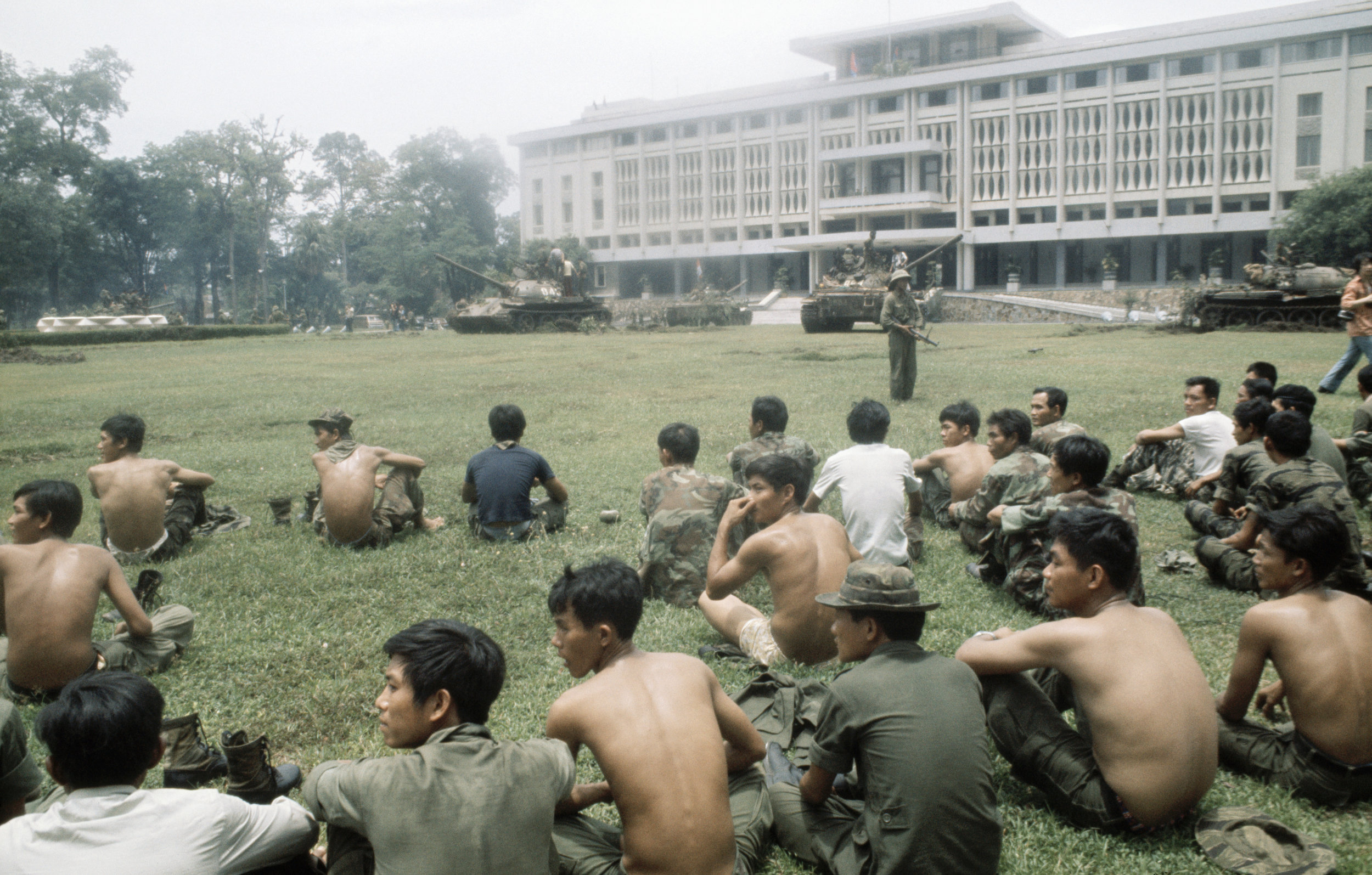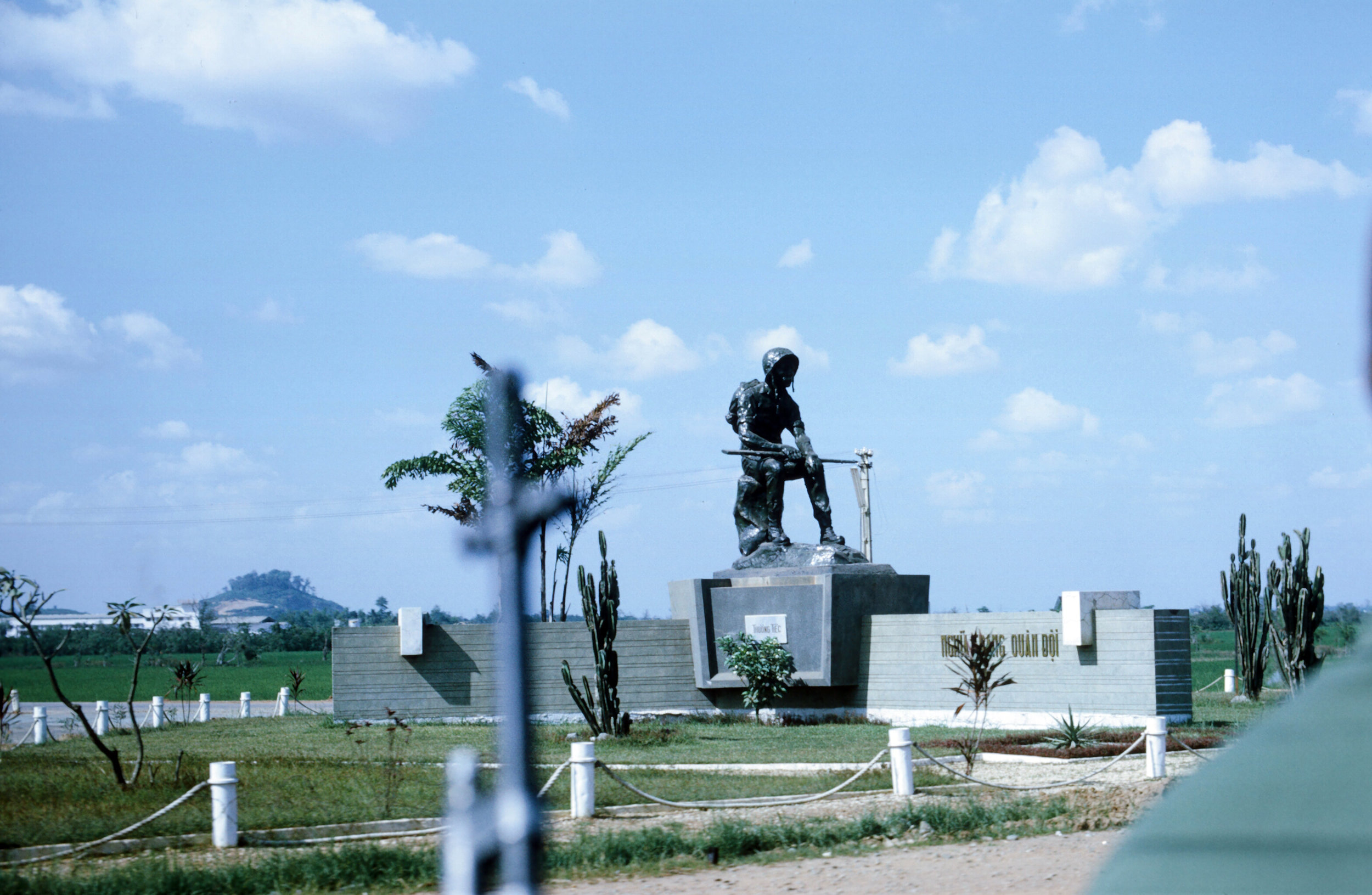Holdouts

Many American writers state that the ARVN had little cohesion by the end of April 1975, preferring to paint the capital in a state of disarray, giving very little agency to the South Vietnamese. However, the organizational situation in the Delta calls this portrayal into question.
C-119K shot down by SA-7 SAM above the TSN runway on April 29 at 0700 hrs.
In contrast to the hectic situation in and around Saigon, the situation in the Mekong Delta was substantially different. The North Vietnamese had not managed to capture and hold any of the provincial capitals and ARVN units had able to keep the roads relatively clear of Viet Cong interdiction, keeping routes open for travel. Prior to the Spring Offensive, Major General Nguyen Khoa Nam, commander of IV Corps, was well regarded by his men; Major Dang Van Son, of the ARVN Special Forces, said this of Nam: “General Nguyen Khoa Nam was a very good general who had a lot of talent and who was a very loyal person. Nam was a person who liked to carry out military operations.” Nam’s newly assigned deputy corps commander, Brigadier General Le Van Hung, was well known for his role during the siege of An Loc and was considered an upstanding and experienced commander by both the Americans and Vietnamese.
The Mekong Delta had seen none of its provincial capitals seized or attacked in any significant manner or for any sustained period of time throughout the entire conflict. The Delta had open lines of transportation and communication to Saigon and the area remained relatively clear of communist agents and enemy soldiers due to the military operations undertaken by the IV Corps commanders. Although the occasional raid or attack did occur in the Delta region, many civilians remained able to travel freely without fear of attack.
Witnessing this situation and recognizing the opportunity, Khoa and Hung made secret plans to create a redoubt in the Mekong Delta in the case that Saigon fell and the United States chose not to intervene militarily. They told almost no one besides their direct subordinates or their immediate family members of the plans. Titled Operation Linking Hands, the two generals planned to reposition and assign troops, weapons, ammunition, and supplies into bases and staging areas hidden away in the delta. There they would form a redoubt around Can Tho, fighting on for at least several months in the hopes that they could force a ceasefire or negotiated settlement from the North and Viet Cong or provoke a military response from the United States. Other South Vietnamese soldiers were aware of MR IV’s situation, and made attempts at a breakout to the Delta. Le Tran Nhan, an instructor at the Vung Tau Training Center, said “I set out with some of my students, some of my trainees to try to go to IV Corps because the IV Corps wasn't touched. So we think we have better resistance there.”
At the same time and apparently independent of General Nam and Hung, President Thieu had drawn up preliminary plans to break out of the Saigon encirclement using the remaining armor units available and open National Highway Route Four to Can Tho. Once the siege lines were broken, ARVN units could then form an armored column, escorting troops and whatever civilians they could to the delta regions. A single division would be used to delay the PAVN until the column could evacuate. Upon reaching Can Tho, the bridges over the Mekong River would be destroyed, preventing North Vietnamese armor from pursuing over the unstable terrain and rivers of the Delta. The coming spring monsoon rains would then hamper communist troop movements and resupply efforts, delaying any further offensive. The North Vietnamese Politburo had hoped to achieve final victory by Ho Chi Minh’s birthday in 1976—if this plan had delayed the offensive from ultimately destroying the ARVN in one fell swoop, it had the potential to stave off defeat while severely depleting the morale of North Vietnamese troops, who had hoped for a relatively quick and bloodless battle for Saigon. A protracted siege of ARVN strongholds in the Delta by tired, overextended communist forces would not have been easy operation, especially during the rainy season.
VNAF aircraft shot down over Saigon, April 1975.
The ARVN logistical command estimated “that it could supply gasoline and ammunition for the next 15 days if the depots were not lost to the enemy.” Considering the strength of the communist units encircling Saigon, 15 days would have been enough. This estimate included an analysis of supplies in available to the Saigon defenders in MR III in additional to the intact supply depots, army bases, and air fields located in the Delta. These preliminary plans and logistical estimates suggest that a possible, though limited South Vietnamese holdout being possible although unlikely considering the rate of desertion in the final days of the war. Even former Vice President and Air Marshal Nguyen Cao Ky, who had assisted in the coordination of air force sorties during the defense of Saigon, personally offered to lead an armored column out of the city. Ky insisted up until the end there was a possibility that the ARVN could regroup in the Delta, going so far as to ask an American Department of Defense advisor, “If I decide to go south and regroup the troops down the Mekong River, the Delta, and continue the fight, you think the American government will support the idea?” The obvious answer to that hopeful question was a resounding “no.”
French generals who had maintained close personal ties to several ARVN generals flew to Saigon in its final days to assist the ARVN Joint General Staff with planning and help turn the city into South Vietnam's version of Stalingrad during World War II. These generals—Gilles, Bigeard, and Langlais—had all become famous in their service during the First Indochina War. Furthermore, wild rumors swirled among the civilian population of Saigon, with some speculating that President Thieu (who was actually in the process of resigning and turning his government over to the vice president, Tran Van Huong) would move the government to Phu Quoc Island, much as the Nationalist Chinese had done in their civil war. However, this final line of defense was considered by Thieu to be implemented only if American aid was obviously forthcoming. Although there were ARVN units stationed at Phu Quoc, they were isolated, without any heavy equipment such as heavy anti-tank weapons or even armored vehicles, and it would have been nearly impossible to move any substantial force from the defense of Saigon to the island without heavy casualties either by air or by water.
In any case, none of these elaborate plans ever came to fruition. The entire redoubt plan came down to the ability of the South Vietnamese troops to break the siege and then maintain an orderly retreat down QL-4 to Can Tho. Using the evacuation from the Central Highlands as an example of the South Vietnamese ability to organize an orderly retreat seems to imply the sheer logistical nightmare that this would have produced. The heavy lift capability of the VNAF had all but vanished by the final days before Saigon fell, and during the last evacuation, most of the VNAF and ARVN helicopters were in the process of being piloted to Thailand and the U.S. 7th Fleet anchored off the coast. Thieu’s plan to evacuate to Phu Quoc Island would have depended on an air evacuation, as a land evacuation through the entire delta region would be impossible with multiple PAVN divisions interdicting the roads.
ARVN Airborne Division soldiers, April 1975.
By this point in the war, the South Vietnamese had begun to run out of artillery and small arms ammunition, grenades, anti-tank weapons, and even basic necessities such as medical supplies and rations. Although the South Vietnamese estimated they had enough supplies for two weeks, it is unclear how this would have been apportioned and assigned to the surviving ARVN units. Although piecemeal units and been refit and resupplied for the defense of Saigon, the PAVN advance and encirclement meant many supply depots had been overrun. Additionally, having the severely understrength 22nd Infantry Division hold the communist advance for a breakout would likely have resulted in failure. Most likely, the rear guard would have also required redeployment of airborne units and ranger units, who were engaged in heavy combat with communist armor penetrating Saigon, as well as the III Corps Armored Task Force, which was fighting a delaying action close to Bien Hoa Air Base. To redeploy these units, which were in heavy contact with North Vietnamese infantry and armor, would have required a tactical withdrawal which the ARVN would likely not have been capable of at the time. However, the Easter Offensive had proved that the ARVN was capable of siege-breaking, like at An Loc under General Hung, which must have contributed to the hope of Operation Linking Hands.
Colonel Ho Ngoc Can ignored the ceasefire order and continued to fight with his soldiers. He was captured on May 1st, 1975 and executed on August 14.
In the end, soldiers who had fought on or stayed behind in the hopes that the Republic of Vietnam could be preserved had their hopes dashed when President Duong Van Minh ordered a ceasefire. Although most would lay down their arms, hoping to either escape the country or go into hiding, anecdotal reports indicate that a few units kept fighting on the night of April 30th and even the morning and afternoon of May 1st. Several ARVN commanders either ignored the order or did not receive it due to communications being severed during combat situations. According to communist reports, several units remained fighting in place following the ceasefire. These units, cut-off and without any hope of resupply or commands from higher-ups kept on fighting even when they knew all hope was lost and in the face of the collapse of their government, which speaks volumes of their resolve to fight. In the end, all of these units surrendered or were destroyed in their entirety. In 55 days, the Republic of Vietnam had ceased to exist. Following the fall of Saigon, there were reportedly hundreds of suicides, primarily from RVNMF officers who did not want to be captured, including three brigadier generals and two major generals. Ever loyal to the republic, they believed death was a preferable alternative to defeat.
This post was adapted from a long-form academic paper on the strategic and tactical capabilities of the Republic of Vietnam Military Forces in April 1975.








